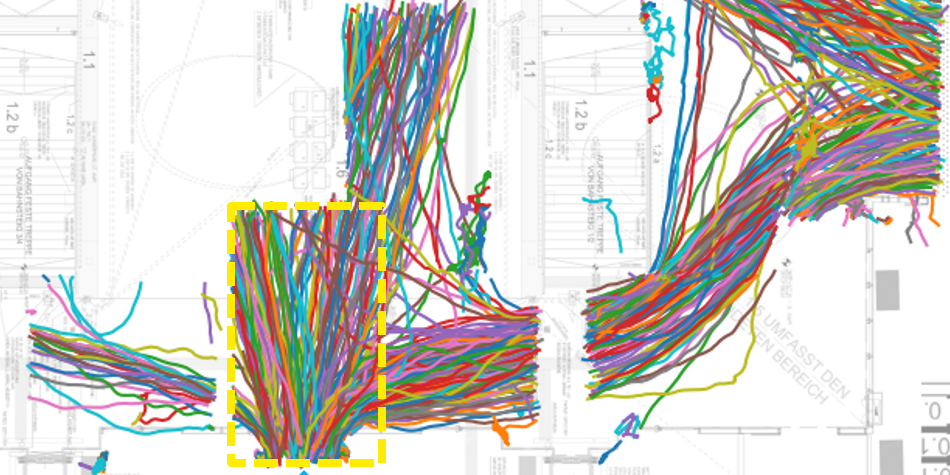Analyzing the Effects of a Column in front of a Bottleneck in a Transportation Infrastructure using Real-World Trajectories
DOI:
https://doi.org/10.17815/CD.2024.182Keywords:
Real-world experiments, Real-world data, Interventions, Transport infrastructure, Pedestrian movementAbstract
In this paper, the effects of placing a column in front of a bottleneck in a real environment under everyday conditions are investigated regarding to person densities, pedestrian flows and personal distances. The study area is a transport infrastructure in Vienna with an attached shopping mall and the column was positioned at various locations in front of the entrance of the shopping mall. For the data analysis, the person trajectories of several scenarios were recorded using video-based sensors. In the scenarios with the column, the densities in front of the bottleneck increased but flows got a nuance smoother with less stop-and-go movements.
References
Hoogendoorn, S., Daamen, W.: Pedestrian behavior at bottlenecks. Transp. Sci. 39, 147–159 (2005). doi:0.1287/trsc.1040.0102
Seyfried, A., Passon, O., Steffen, B., Boltes, M., Rupprecht, T., Klingsch, W.: New insights into pedestrian flow through bottlenecks. Transp. Sci. p. 395–406 (2009). doi:10.1287/trsc.1090.0263
Garcimartín, A., I., Z., Pastor, J., Martín-Gómez, C., Parisi, D.: Experimental evidence of the ‘faster is slower’ effect. Transp. Res. Procedia 2, 760–767 (2014). doi:10.1016/j.trpro.2014.09.085
Ronchi, E., Nilsson, D., Kojić, S., et al.: A virtual reality experiment on flashing lights at emergency exit portals for road tunnel evacuation. Fire Technol. 52, 623ff (2016)
Liao, W., Seyfried, A., Zhang, J., Boltes, M., Zheng, X., Zhao, Y.: Experimental study on pedestrian flow through wide bottleneck. Transportation Research Procedia 2, 26-33 (2014). doi:10.1016/j.trpro.2014.09.005. The Conference on Pedestrian and Evacuation Dynamics 2014 (PED 2014), 22-24 October 2014, Delft, The Netherlands
Helbing, D., Farkas, I., Molnar, P., Vicsek, T.: Simulation of pedestrian crowds in normal and evacuation situations. In: Schreckenberg, M., Sharma, S.D. (eds.) Pedestrian and Evacuation Dynamics, vol. 21, p. 21–58. Springer (2002)
Yanagisawa, D., et al.: Introduction of frictional and turning function for pedestrian outflow with an obstacle. Phys. Rev. E 80 (2009). doi:10.1103/PhysRevE.80.036110
Shiwakoti, N., Shi, X., Ye, Z.: A review on the performance of an obstacle near an exit on pedestrian crowd evacuation. Safety Science 113 (2019)
Corbetta, A., Kroneman, W., Donners, M., Haans, A., Ross, P., Trouwborst, M., Van de Wijdeven, S., Hultermans, M., Sekulovski, D., van der Heijden, F., et al.: A large-scale real-life crowd steering experiment via arrow-like stimuli. Collective Dynamics 5, 61–68 (2018)
Savitzky, A., Golay, M.: Smoothing and differentiation of data by simplified least squares procedures. Analytical Chemistry 36 (8), 1627–39 (1964). doi:10.1021/ac60214a047
Corbetta, A., Bruno, L., Muntean, A., Toschi, F.: High statistics measurements of pedestrian dynamics. Transportation Research Procedia 2, 96-104 (2014). doi:10.1016/j.trpro.2014.09.013. The Conference on Pedestrian and Evacuation Dynamics 2014 (PED 2014), 22-24 October 2014, Delft, The Netherlands
Steffen, B., Seyfried, A.: Methods for measuring pedestrian density, flow, speed and direction with minimal scatter. Physica A 389, 1902–1910 (2010). doi:10.1016/j.physa.2009.12.015

Downloads
Published
How to Cite
Issue
Section
Categories
License
Copyright (c) 2024 Thomas Matyus, Martin Stubenschrott, Stefan Seer, Christian Kogler

This work is licensed under a Creative Commons Attribution 4.0 International License.
Authors contributing to Collective Dynamics agree to publish their articles under the Creative Commons Attribution 4.0 license.
This license allows:
Share — copy and redistribute the material in any medium or format
Adapt — remix, transform, and build upon the material
for any purpose, even commercially.
The licensor cannot revoke these freedoms as long as you follow the license terms.
Authors retain copyright of their work. They are permitted and encouraged to post items submitted to Collective Dynamics on personal or institutional websites and repositories, prior to and after publication (while providing the bibliographic details of that publication).








